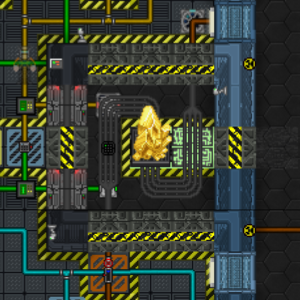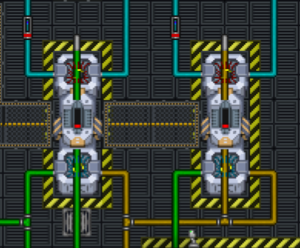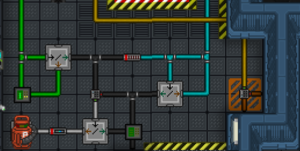Guide to Engines: Difference between revisions
m (→The Radiators) |
|||
| (One intermediate revision by the same user not shown) | |||
| Line 1: | Line 1: | ||
General guide to the power sources of the SGV Dagon. | General guide to the power sources of the SGV Dagon. | ||
== | == Supermatter Fundamentals == | ||
[[File:Sm1.png|thumb|A Supermatter Crystal in its natural habitat]] | [[File:Sm1.png|thumb|A Supermatter Crystal in its natural habitat]] | ||
| Line 20: | Line 20: | ||
=== The Filters === | === The Filters === | ||
Filters are what are used to remove unwanted contaminants from both loops. The SM emits many types of gasses while energized. One of these gases, Oxygen, will react with both hydrogen, and phoron. This creates water, and carbon dioxide respectively. As a result of this, if water and/or carbon dioxide are filtered out from the hot loop, this will result in a gradual, albeit usually safe rate of coolant loss. So be sure to choose your filter settings carefully. | Filters are what are used to remove unwanted contaminants from both loops. The SM emits many types of gasses while energized. One of these gases, Oxygen, will react with both hydrogen, and phoron. This creates water, and carbon dioxide respectively. As a result of this, if water and/or carbon dioxide are filtered out from the hot loop, this will result in a gradual, albeit usually safe rate of coolant loss. So be sure to choose your filter settings carefully. | ||
=== Personal Protective Equipment (PPE) === | |||
This is what keeps you safe when you're working in the engine room. This consists of your radiation suit, radiation hood, and meson goggles. The radiation suit, as you may have guessed, protects you from the harmful, and sometimes lethal amount of radiation the SM emits. And the meson goggles protect your brain from directly observing it's brilliance, which can harm you and cause hallucinations. | |||
== Basic Setup == | |||
=== Phase 1: Planning === | |||
The first step in starting up the engine the is the planning phase. This is when you will decide what gases you wish to inject into the loops, whether or not you will use radiation collectors, and other details. These decisions should be made by whichever engineer is going to be performing the setup to ensure that the plan is not above their skill level or abilities. These decisions should be communicated to the rest of the engineering team so that they can assist, or be aware of modifications you have made that may affect emergency procedures, in the event you are not available to perform them. | |||
=== Phase 2: Setup === | |||
Once you are preparing to enter the engine room to begin the setup phase, it is wise to put on your PPE, it may feel unnecessary at this point, because the SM isn't energized, but should one of your coworkers slip and collide with the SM crystal, it will rapidly become energized. Make any modifications that you've planned out in the planning phase first, this is easiest to do when the SM chamber and it's pipes aren't full of highly pressurized, scorching hot, radioactive gas. | |||
Once you have completed previously planned modifications, it's wise to set the filters first. If your filters are not set correctly before you inject coolant, they will proceed to filter out your coolant until you configure them properly, or the SM delaminates, whichever happens first. Then, you may begin injecting coolant by wrenching your coolant canisters onto the injection ports, and setting their pumps on, and maximizing their desired pressure. It's a good idea to do this second, because it takes a lot of time to complete. | |||
As your coolant is being pumped into the hot and cold loops, you can save time by configuring the two high power gas pumps on the cyan colored cold loop, near the TEGs: (Picture reference needed). As well as going ahead and hitting the Max Flow button on the Engine Cooling Control console in the engine monitoring room, if you haven't already. | |||
Latest revision as of 03:37, 30 March 2022
General guide to the power sources of the SGV Dagon.
Supermatter Fundamentals

The Supermatter Crystal (SM)
The supermatter crystal is the source of engineering’s power. It puts out both heat and radiation when energized by lasers, both of which can be turned into electrical energy to power the ship. As the crystal generates heat, it will pass that heat to the gasses surrounding it in it’s chamber. These gasses are consequently referred to as coolant, regardless of which particular gas you are cooling the SM with.
If this heat cannot be moved away from the SM and into the coolant, it will cause the SM to start losing it’s integrity, which will eventually cause delamination. There is a vent in the SM chamber that removes the coolant and pipes it to what is referred to as the hot-loop.

The Thermo-Electric Generator (TEG)
The thermo-electric generator takes the heat it receives from the SM’s hot-loop, and uses it to generate electricity by transferring that heat to what is referred to as the cold-loop. It is the differential of heat between the hot-loop and cold-loop that allows the TEG to generate electricity. As the heat is transferred between the two loops during the process, this effectively cools the hot-loop as well, allowing it to better cool the SM itself. No gas is transferred between the hot and cold pipes, only heat.

The Radiators
The radiators are simply an array of pipes that are passed through the hull of the ship, and out into space, these pipes are particularly thermally conductive, allowing the heat from the pipes to be radiated away into space. This process is what keeps the cold-loop coolant colder than the hot-loop, so that it can continue to be used to generate electricity.

The Filters
Filters are what are used to remove unwanted contaminants from both loops. The SM emits many types of gasses while energized. One of these gases, Oxygen, will react with both hydrogen, and phoron. This creates water, and carbon dioxide respectively. As a result of this, if water and/or carbon dioxide are filtered out from the hot loop, this will result in a gradual, albeit usually safe rate of coolant loss. So be sure to choose your filter settings carefully.
Personal Protective Equipment (PPE)
This is what keeps you safe when you're working in the engine room. This consists of your radiation suit, radiation hood, and meson goggles. The radiation suit, as you may have guessed, protects you from the harmful, and sometimes lethal amount of radiation the SM emits. And the meson goggles protect your brain from directly observing it's brilliance, which can harm you and cause hallucinations.
Basic Setup
Phase 1: Planning
The first step in starting up the engine the is the planning phase. This is when you will decide what gases you wish to inject into the loops, whether or not you will use radiation collectors, and other details. These decisions should be made by whichever engineer is going to be performing the setup to ensure that the plan is not above their skill level or abilities. These decisions should be communicated to the rest of the engineering team so that they can assist, or be aware of modifications you have made that may affect emergency procedures, in the event you are not available to perform them.
Phase 2: Setup
Once you are preparing to enter the engine room to begin the setup phase, it is wise to put on your PPE, it may feel unnecessary at this point, because the SM isn't energized, but should one of your coworkers slip and collide with the SM crystal, it will rapidly become energized. Make any modifications that you've planned out in the planning phase first, this is easiest to do when the SM chamber and it's pipes aren't full of highly pressurized, scorching hot, radioactive gas.
Once you have completed previously planned modifications, it's wise to set the filters first. If your filters are not set correctly before you inject coolant, they will proceed to filter out your coolant until you configure them properly, or the SM delaminates, whichever happens first. Then, you may begin injecting coolant by wrenching your coolant canisters onto the injection ports, and setting their pumps on, and maximizing their desired pressure. It's a good idea to do this second, because it takes a lot of time to complete.
As your coolant is being pumped into the hot and cold loops, you can save time by configuring the two high power gas pumps on the cyan colored cold loop, near the TEGs: (Picture reference needed). As well as going ahead and hitting the Max Flow button on the Engine Cooling Control console in the engine monitoring room, if you haven't already.